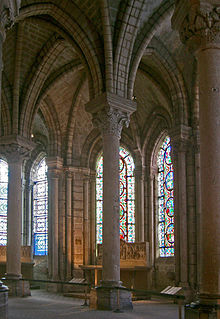 Ambulatory of the Basilica of Saint-Denis | |
| Years active | c. 1129-1200 |
|---|---|
| Location | France, England, Germany |
Early Gothic is the term for the first period of Gothic architecture which lasted from about 1120 until about 1200. The early Gothic builders used innovative technologies to resolve the problem of masonry ceilings which were too heavy for the traditional arched barrel vault. The solutions to the problem came in the form of the rib vault, where thin stone ribs passed the weight of the ceiling to rows of columns and outside the walls to another innovation, the flying buttress.
Gothic appeared in the Île-de-France region of France, around Paris, and spread quickly to other regions, and to England and Germany. It combined several existing technologies, notably the rib vault, pointed arch, flying buttress, to build much higher and thinner walls, which allowed more space for stained glass windows and more light in the interior. [1]
Early examples of Early Gothic include the east end, chapels and ambulatory of the Abbey of Saint Denis in Paris, (1135-1144). The style soon spread from the Paris region to other parts of France, and then to England. Notable examples of early English Gothic include the Trinity Chapel of Canterbury Cathedral, built under the supervision of William of Sens, who had worked on Sens Cathedral, an early example of early French Gothic architecture.
- ^ Enyclopedia Britannica On-Line, "Gothic Architecture" (by subscription), retrieved April 2024